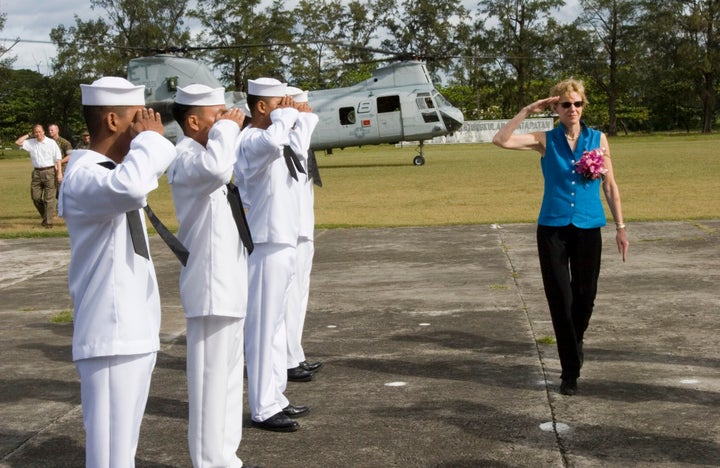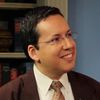
The following is one in a series of adapted excerpts from “Diplomats in the Trenches: Profiles of U.S. Foreign Service Officers.”
Kristie Kenney often seems upbeat and chipper, but on the day I first met her in 2012 in Bangkok, where she was the U.S. ambassador, she was especially excited, in anticipation of a rare event the next day.
The Boeing Company was flying in its newest commercial plane, the Boeing 787 Dreamliner, which she saw as an opportunity to promote the U.S. aircraft industry, and American business in general. An added bonus was the fact that the president of Boeing for Southeast Asia who also flew in for the event, Ralph Boyce, was one of Kenney’s predecessors at the embassy in Bangkok, whom many Thais still remembered because of his superb command of their language.
An event with the U.S. ambassador in almost any country would attract media attention, and Kenney used the chance to showcase issues she deemed important to American interests. Promoting U.S. business and expanding trade was one of the top issues on her agenda. “Every single day of the year we promote American companies and help to find new opportunities for Americans to do business here,” she said. “It starts with me wearing a Coca Cola T-shirt at a basketball game or carrying a Starbucks cup.”
Not long after the Boeing event, Kenney gave a speech at Cotton Day, organized by Cotton USA to promote American cotton exports. She wore a dress made entirely of U.S. cotton.
Diplomatic success is often difficult to measure ― many results are long-term, and the absence of conflict is rarely seen as a victory or a reason to reward someone. If there is one area where the results are as obvious and immediate as they get, it’s economic and business diplomacy. Helping U.S. companies to compete on a level playing field and generate more revenue abroad, so they can contribute more to prosperity at home, is always a priority. The challenge is to ensure that those efforts truly benefit the United States and the American people, rather than just serve corporate interests and enrich powerful private businesses.

Along with her routine ambassadorial duties in Thailand, Kenney had her share of crises ― both political and natural. In 2014, she had to deal with a military coup, following months of unrest. In 2011, devastating floods almost paralyzed the country, and Kenney quickly requested permission from Washington to help the Thais recover from the disaster. “We put together a flood relief package in literally 24 hours,” she recalled. “I even got on the phone with Marine commanders in Okinawa, U.S. Pacific Command, and our commercial guys.”
Having arrived in Bangkok soon after the 2010 WikiLeaks release of more than 250,000 diplomatic cables, some of which were secret, Kenney was concerned about the impact the public airing of private communications involving Thailand would have on her embassy’s ability to do its job. Some of the post’s sources “felt betrayed” when they read the cables, she said, but the “good news” is that many “still want to be engaged” with the United States. “Although there are certain people who will be more reticent with us, in general, they are interested in America and want to deal with us, so they are not going to shut us off,” she added.
Kenney joined the Foreign Service in 1980 and has also been ambassador to the Philippines and Ecuador. She returned from Bangkok in 2014 and later became the counselor of the State Department, a position equal to undersecretary that provides strategic guidance to the secretary of state. She has witnessed significant changes in the conduct of U.S. diplomacy over the years. One of the them is the growing number of government agencies besides the State Department represented at embassies and consulates ― and the increased numbers of their people serving there. In fact, an embassy today often resembles a mini-government.
The embassy in Bangkok is one of the biggest, with about 40 agencies working on both the bilateral U.S.-Thai relationship and broader regional issues. There are more than 600 people focusing on global health issues, Kenney said, including employees of the Department of Health and Human Services and the Centers for Disease Control and Prevention, as well as Armed Forces medical personnel, who run a mosquito lab. According to the State Department, the United States works “to strengthen public health systems in more than 50 countries,” and U.S. “health investments are at work” in almost 80 countries.
Because of the large number of people from various agencies in Bangkok attending the weekly meetings of the so-called country team, which consists of the embassy’s leadership and heads of sections, some members weren’t familiar with their colleagues’ work. Kenney said she was “dogmatic” about not using acronyms in the meetings. “You all work for the same government,” she said. “You can’t give me a sentence that includes acronyms and make the rest of the room think they have no idea what you are talking about.”
When Kenney decided on a diplomatic career after graduate school, her family wasn’t the most understanding and wondered why she wanted to live far away from them. “My mother was furious and stopped talking to me for a couple of months,” Kenney recalled. “She didn’t want me living overseas. But then I ended up marrying a colleague, and she came around.”
The life of Foreign Service spouses has long been more difficult than that of officers ― they often have to sacrifice their own careers. To solve that problem, some spouses also join the service, only to discover that it’s not that easy for “tandem couples” to secure jobs at the same post.
When Kenney was in Thailand, her husband, William Brownfield, was assistant secretary of state for international narcotics and law enforcement affairs in Washington ― he still holds that position. “When he was in Venezuela, I was in Ecuador for half of his tour and Manila for the other half,” Kenney said. The more senior you get in the service, the more difficult it gets to stay together, she said. Kenney and Brownfield did serve together in several countries, including Argentina and Switzerland, earlier in their careers, and “spent a lot of time in Washington.”
Another major change Kenney has witnessed in the Foreign Service is the much wider variety of duties and responsibilities officers have today ― a consequence of the deep U.S. engagement across the world. The State Department’s focus on having a more diverse diplomatic service in terms of ethnicity and professional background is fitting, she said, though it still has a long way to go. “We come in all shapes and sizes,” she added.
As ambassador, Kenney said she strived for “good moral, a happy workforce and treating people right” at her embassies. It wasn’t always easy, and she acknowledged having challenges, including one with a first-tour officer at a previous post. “She needed more coaching and mentoring, and we provided that,” Kenney said. “Her immediate boss brought it to me very quickly, and we gave her every opportunity to learn and get extra help. But in the end, it wasn’t enough. We all recognized it wasn’t a great fit. It was entry level, so the system took care of it ― she didn’t get tenured and had to leave the service.” Officers must qualify for tenure within five years of joining the Foreign Service or resign.
“Living overseas can be different from what people expect, or they may not be doing what they thought they would do at work, or perhaps their families are unhappy,” Kenney said. “Things happen.”
Photos by U.S. Mission Thailand and U.S. Navy
